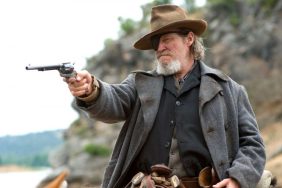The Raven opens on Friday, and that has me, along with a probable mass of people, reaching for their Edgar Allan Poe volumes. Poe (1809-1849) is, I think we can all agree, the reigning kind of macabre fiction, and is, perhaps, one of the most significant American authors; he could be listed alongside Melville and Whitman. Any good goth kid worth their weigh in eyeliner has a copy of the complete works of Poe, and is likely familiar with some of his more violent stories. Who amongst us can’t recite a line or two from The Raven? Or read The Tell-Tale Heart at perhaps too early an age?
Hollywood has been an intimate friend of Poe’s since the inception of the form. On The Internet Movie Database, Poe’s first film credit goes all the way back to 1908, when his story, “The Murders in the Rue Morgue” was repurposed for a Sherlock Holmes adventure. Which may, when you think about it, be one of the earliest movie pop-culture mashups. Since then, Poe has been credited to about 250 films and TV shows over the years. Some have been rather good, while other have been downright exploitative (I once saw a 1990 Jim Wynorski film called The Haunting of Morella which was little more than an excuse to film busty women stripping in a castle). But a select few have been truly great. This week on Five Great Movies, I have culled through the Poe films I have seen, and come up with the following list of old, perhaps obscure, but all remarkable Poe adaptations.
The Fall of the House of Usher (dir. Jean Epstein, 1928)

This atmospheric silent classic is particularly notable for its screenplay, which was co-penned by the surrealist cinema master Luis Buñuel. Poe’s original story was about a family of recluses, all of the line of Usher, who had to face the inevitable physical crumbling of the old family estate under the weight of centuries of familial iniquities. There is more than a little bit of incest hinted at in the story. Epstein’s gorgeous film focuses on the long alimentary-like corridors and slow entropic internal deterioration of the ghostly mansion itself. The film is a grand testimony to a parallel between an empty moral life, and the physical breakdown that matches it. Without words, it manages to capture the pulp macabre sensibility of Poe, while accurately also capturing his keen eye for gut-wrenching tragedy.
The Black Cat (dir. Edgar G. Ulmer, 1934)

The Black Catcame out during the rise of the Universal Monster Film’s golden era. And while it has never achieved the worldwide fame of a Dracula or a Frankenstein, is still bears the beautifully twisted 1930s horror sensibility of those classics. The story of the film has actually very little to do with the original story, about a man who bricked his murder victim up behind a wall (hiding dead bodies is a common theme in Poe), following, as it does, a Satanic priest who looks after a car-wrecked traveling couple, but it’s still wildly atmospheric, and has wonderfully towering horror actors to menace our heroes. No one less than Boris Karloff plays the Satanic priest Hjalmar Poelzig, and the even-more-towering Bela Lugosi plays the wounded Hungarian doctor who must match wits (and even play a deathly game of chess) with Poelzig. Again, it drifts from Poe (as so many of his films do), but it’s still one of the great horror films.
The Tell-Tale Heart (dir. Ted Parmelee, 1953)

There have been dozens of short films based on Poe (you’ll find that the vast bulk of Poe-adapted films are anthology films), and few are as creepy as this obscure 1953 animated oddity. Narrated by James Mason, this film was the first cartoon short in film history to receive an “X” rating by the British ratings board. It’s clear to see why. The film, while containing no huge amount of blood, and having no nudity, accurately depicts the madness of the Tale’s unstable narrator, and his crazed quest to murder his elderly roommate for no other reason than the old man’s milky white eye creeped him the Hell out. The short is an Edward Gorey-like Gothic masterpiece of expressionistic design, with a frame that is often filled with the pulsating internal veins of the killer’s POV. The Tell-Tale Heart is an amazing story to begin with, and can give nightmares to any of the most casual readers. This animated short actually captured the creep factor as best as I can imagine.
Tales of Terror (dir. Roger Corman, 1962)

Written by prolific genre scribe Richard Matheson, and directed by Hollywood’s most notorious B-Movie mogul Roger Corman, Tales of Terror is easily the most fun of the cinematic Poe canon. An anthology film of three shorts, Tales of Terror plays like a comedy which only happens to have murder in it. The shorts include an adaptation of The Case of M. Valdemar (with Basil Rathbone and Vincent Price), and a Morella segment (also with Vincent Price), but my favorite is the short based on The Black Cat, wherein Peter Lorre, in fine form, plays a slovenly drunk who playfully walls the dandy Vincent Price behind bricks, all while having a casual conversation with him. Roger Corman has actually masterminded several Poe adaptations, and its likely you’ve seen at least one of them over the years, and some say it was the relatively high-profile horror films that gave Corman his name. If you want a more serious Corman/Poe film, go for The House of Usher (1960). If you want something to make you grin grimly, go for Tales of Terror.
Spirits of the Dead (dir. Roger Vadim, Louis Malle, Federico Fellini, 1968)

An anthology film that collected a prestigious group of known art house directors to each adapt a different rarely-filmed Poe story (no pendulums or ravens in this lot), Spirits of the Dead is actually a confusing, arch, and perhaps overthought piece of Poe-like abstraction that alienated audiences at the time, and only stands today as a bizarro footnote in the careers of these well known European auteurs. How many of you have read Poe’s story Metzengerstein? I’m willing to bet that it is few of you. The film features numerous notable actors, including Jane Fonda, Brigitte Bardot, Alain Delon, and Peter Fonda. And while the movie is messy like crazy, that’s the very reason I appreciate it. It bares the classy, opulent, over-the-top upper-class Eurotrash sensibilities of Ken Russell. The best of the three is Toby Dammit, Fellini’s segment, starring Terrence Stamp as a famous actor (updated from the Shakespearean actor of the source story) who seems to be constantly sweating, wears a flouncy oddball cape, and is clearly tripping on huge amounts of LSD. This film seems to stray very far from Poe’s original tales, but I’m a sucker for Eurotrash rococo explosions.
Come back next week for more Five Great Movies!








